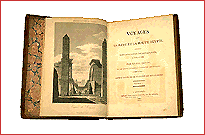 One
captures a fascination with history, especially ancient history, to which
europe looked for the roots of its civilization. Intellectuals of the time
were also intrigued with cultures unlike their own--the exotic, the different,
the "uncivilized." The desire to know this history and culture was
complemented by the urge to collect it in the form of images, antiquities,
artifacts, and even colonial territories. For those who could not travel to
see historic locales, books brought information and pictures. Real or imaginary,
they had the power to preserve time. One
captures a fascination with history, especially ancient history, to which
europe looked for the roots of its civilization. Intellectuals of the time
were also intrigued with cultures unlike their own--the exotic, the different,
the "uncivilized." The desire to know this history and culture was
complemented by the urge to collect it in the form of images, antiquities,
artifacts, and even colonial territories. For those who could not travel to
see historic locales, books brought information and pictures. Real or imaginary,
they had the power to preserve time. |
|
